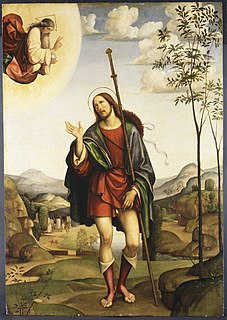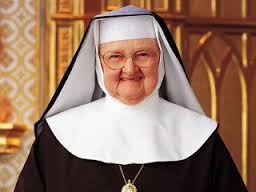
Élisabeth Louise Vigée Le Brun, also known as Madame Le Brun, was a French portrait painter, especially of women, in the late 18th and early 19th centuries.

Faith healing is the practice of prayer and gestures that are believed by some to elicit divine intervention in spiritual and physical healing, especially the Christian practice. Believers assert that the healing of disease and disability can be brought about by religious faith through prayer or other rituals that, according to adherents, can stimulate a divine presence and power. Religious belief in divine intervention does not depend on empirical evidence of an evidence-based outcome achieved via faith healing. Virtually all scientists and philosophers dismiss faith healing as pseudoscience.

The University of Paris, metonymically known as the Sorbonne, was the leading university in Paris, France, active from 1150 to 1970, with the exception of 1793–1806 under the French Revolution. Emerging around 1150 as a corporation associated with the cathedral school of Notre Dame de Paris, it was considered the second-oldest university in Europe.

Maria Anna Angelika Kauffmann, usually known in English as Angelica Kauffman, was a Swiss Neoclassical painter who had a successful career in London and Rome. Remembered primarily as a history painter, Kauffmann was a skilled portraitist, landscape and decoration painter. She was, along with Mary Moser, one of two female painters among the founding members of the Royal Academy in London in 1768.

François Auguste Marie Mignet was a French journalist and historian of the French Revolution.

In the teaching of the Catholic Church, an indulgence is "a way to reduce the amount of punishment one has to undergo for sins". The Catechism of the Catholic Church describes an indulgence as "a remission before God of the temporal punishment due to sins whose guilt has already been forgiven, which the faithful Christian who is duly disposed gains under certain prescribed conditions through the action of the Church which, as the minister of redemption, dispenses and applies with authority the treasury of the satisfactions of Christ and all of the saints".

A grande école is a specialised elite university that is separate from, but parallel and often connected to, the main framework of the French public university system. The grandes écoles offer teaching, research and professional training in single academic fields such as engineering, architecture, business administration, academic research, or public policy and administration. The schools only admit students through an extremely competitive examination process; a significant proportion of their graduates occupy senior positions in French business, academia, civil service and civil society.

Sébastien-Roch Nicolas, known in his adult life as Nicolas Chamfort and as Sébastien Nicolas de Chamfort, was a French writer, best known for his epigrams and aphorisms. He was secretary to Louis XVI's sister, and of the Jacobin club.
The Conservatoire national des arts et métiers is a French public higher education institution, national research centre and grand établissement as well as grande école of engineering, thus part of the French elite universities league. Headquartered in Paris, it has campuses in every major French cities, in overseas France and in every francophone African countries, China, Haiti, Germany, and Switzerland. Founded in 1794 by the French bishop Henri Grégoire, CNAM's core mission is dedicated to provide education and conduct research for the promotion of science and industry. With 70,000 students and a budget of €174 million, it is the largest university in Europe in terms of Budget for distance learning and continued education, and the second largest by enrolment after the University of Hagen. CNAM provides certificates, diplomas, Bachelor's degrees, Master's degrees and PhD's in Science, Engineering, Law, Management (AMBA-accredited), Finance, Accountancy, Urban Planning and Humanities, all designed to abide by the European Bologna process, and thus complying with the European Credit Transfer System. It is the only higher education institution in Europe to provide Physics, Chemistry and Life-Science engineer's degrees up to a PhD-level via distance learning and via its so-called "hybrid learning" which includes intermittent laboratories classes on-site. The CNAM hosts also a museum dedicated to scientific and industrial inventions: Musée des Arts et Métiers which welcomed 250,000 visitors in 2018, and is located on the Parisian campus of the French National Conservatory of Arts and Crafts at 292 rue Saint Martin, in the 3rd arrondissement of Paris, in the historical area of the city named Le Marais.

Saint-Maur-des-Fossés is a commune in the southeastern suburbs of Paris, France. It is located 11.7 kilometres from the centre of Paris.

Cashmere wool, usually simply known as cashmere, is a fiber obtained from cashmere goats, pashmina goats, and some other breeds of goat. It has been used to make yarn, textiles and clothing for hundreds of years. Cashmere is closely associated with the Kashmir shawl, the word "cashmere" deriving from an anglicisation of Kashmir, when the Kashmir shawl reached Europe in the 19th century. Both the soft undercoat and the guard hairs may be used; the softer hair is reserved for textiles, while the coarse guard hair is used for brushes and other non-apparel purposes.

The Angelus is a Catholic devotion commemorating the Incarnation or the Annunciation. As with many Catholic prayers, the name Angelus is derived from its incipit—the first few words of the text: Angelus Domini nuntiavit Mariæ. The devotion is practised by reciting as versicle and response three Biblical verses narrating the mystery, alternating with the prayer "Hail Mary". The Angelus exemplifies a species of prayers called the "prayer of the devotee".

Roch (lived c. 1348 – 15/16 August 1376/79, also called Rock in English, is a Catholic saint, a confessor whose death is commemorated on 16 August and 9 September in Italy; he is especially invoked against the plague. He has the designation of Rollox in Glasgow, Scotland, said to be a corruption of Roch's Loch, which referred to a small loch once near a chapel dedicated to Roch in 1506.

Mother Mary Angelica of the Annunciation, also known as Mother Angelica, was an American Roman Catholic nun of the Poor Clares of Perpetual Adoration. She was best known for the television show Mother Angelica Live. She was the founder of the international broadcast cable television network Eternal Word Television Network (EWTN) and the radio network WEWN. EWTN became a voice for Catholics worldwide.
The Canon of the Mass, also known as the Canon of the Roman Mass and in the Mass of Paul VI as the Roman Canon or Eucharistic Prayer I, is the oldest anaphora used in the Roman Rite of Mass. The name Canon Missæ was used in the Tridentine Missal from the first typical edition of Pope Pius V in 1570 to that of Pope John XXIII in 1962 to describe the part of the Mass of the Roman Rite that began after the Sanctus with the words Te igitur. All editions preceding that of 1962 place the indication "Canon Missae" at the head of each page from that point until the end of the Mass; that of 1962 does so only until the page preceding the Pater Noster and places the heading "Ordo Missae" on the following pages.

Lyon, also spelled in English as Lyons, is the third-largest city and second-largest metropolitan area of France. It is located at the confluence of the rivers Rhône and Saône, 391 km (243 mi) southeast of Paris, 278 km (173 mi) north of Marseille, 113 km (70 mi) southwest of Geneva, and 50 km (31 mi) northeast of Saint-Étienne.
Religious clothing is clothing which is worn in accordance with religious practice, tradition or significance to a faith group. It includes clerical clothing such as cassocks, and religious habit, robes, and other vestments. Accessories include hats, wedding rings, crucifixes, etc.

Fleury François Richard, sometimes called Fleury-Richard, was a French painter of the École de Lyon. A student of Jacques-Louis David, Fleury-Richard and his friend Pierre Révoil were precursors of the Troubador style.
Institut Français de la Mode (IFM) is a higher education institution offering postgraduate courses and applied research for the fashion, luxury goods, design and textile industries, and creative industries more generally. In 2017, IFM was ranked number 1 worldwide for Fashion Business Masters programs, and number 2 worldwide for Fashion Design Masters programs by The Business of Fashion.















